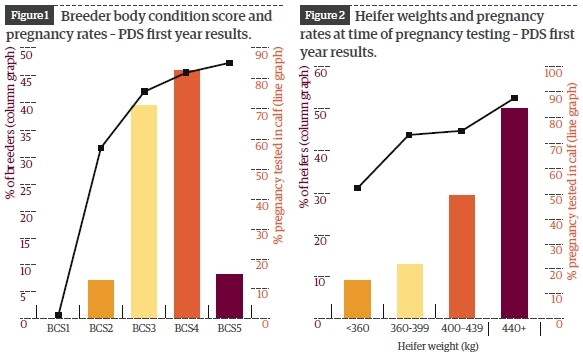Reproductive diseases
Project: Management of reproductive diseases in Central Queensland breeder herds
Location: Emerald and Springsure
Species: Cattle
Date: May 2010 - Dec 2013
Status: Ongoing
Topic: Genetics and breeding
Objectives:
- Assist producers to implement more effective measurement of the reproductive performance of their herds.
- Assist producers to identify where reproductive losses are occurring and their impact i.e. poor conception rates, foetal and neonatal calf losses.
- Review property vaccination programs for leptospirosis and vibriosis to ensure they are in accordance with recommendations and fit most effectively with property management programs.
- Identify the pestivirus status of participating herds and their risk of infection.
- Use the results of pestivirus testing to identify the most appropriate management and vaccination program for participating herds.
- Demonstrate the importance of record keeping and monitoring for decision making and overall herd management.
Progress:
The Billaboo CQ Beef Group members established this PDS in 2009 to investigate the impact of reproductive diseases in cattle on profitability.
Supported by staff from FutureBeef, group members have collected and recorded performance and disease data since 2010. Data includes:
- body condition scores
- pregnancy rates
- losses from pregnancy test to weaning
Project coordinator, Laura Devlin, said the producers wanted to identify where losses were occurring, determine the risk of reproductive diseases on their properties, and implement the most cost-effective strategies for managing the diseases.
The PDS discovered that all herds in the project had been exposed to pestivirus (BVDV) and so also undertook a cost-benefit analysis of vaccination.
Breeder weight and condition score
“The PDS results have highlighted the importance of managing breeder body condition in achieving good reproductive performance,” Laura said.
“Cows in poor condition at calving take longer to ovulate after calving and may not ovulate until weaning. Ideally, cows should be in body condition score three or better at calving.”
The first year’s records also revealed the significance of weight at joining for maiden heifers.
Across the group’s herds, heifers above 440kg achieved an average 87% conception, compared to just 51% for heifers below 360kg at pregnancy testing.

*Source: Queensland Department of Agriculture, Fisheries and Forestry (QDAFF)
Disease management
A critical consideration for the group is managing the key diseases that can cause reproductive losses: vibriosis, leptospirosis and pestivirus.
Vibriosis can be controlled in most situations with a bull vaccination program. Other important measures include culling bulls at seven years and culling empty cows.
Leptospirosis can be managed by vaccinating breeders and bulls. Vaccination also reduces the risk to humans.
Pestivirus outbreaks in Central Queensland have been known to cause foetal and neonatal calf losses of 25–50%.
Blood tests taken in the first year of the project revealed all herds had been exposed to pestivirus. Reproductive losses from the virus are minimised if exposure occurs prior to mating.
A vaccine is available but, once a vaccination program is started, it needs to continue, as the herd will lose all natural immunity.
The two initial doses of the vaccine cost $8.24/head, and the annual booster $4.12/head. Analysis of the cost/benefits of pestivirus vaccination using Breedcow/Dynama software showed that a 2% reduction in foetal and calf losses from pregnancy test to weaning would pay for a whole herd vaccination strategy.
University of Queensland veterinarian Professor Michael McGowan analysed the findings, emphasising that vaccination couldn’t be undertaken in isolation.
“Prof McGowan said there would be little point in vaccinating the older cows because they already showed significant levels of disease exposure and therefore had acquired a natural immunity,” Laura said.
“He suggested a whole herd vaccination strategy could start with the heifers, eventually building up to the whole breeder herd.
“However, biosecurity measures must be put in place, such as keeping new cattle away from the breeding herd, especially if they’re in early pregnancy.”
An important outcome of the PDS has been the implementation of record keeping, which enables producers to better monitor reproductive performance. This is critical for the identification and management of reproductive losses.
Strategies to increase weaning:
- Ensure cows are in body condition score 3 or better at calving
- Stock paddocks according to forage availability
- Wean at the right time and wean early in dry times to ensure cows maintain godd body condition
- Ensure maiden heifers are at a good weight for age at joining to increase chance of conception
- Over-mate and cull heifers on the basis of foetal ageing to select the most fertile animals
- Control joining to limit number of calves born out of season and simplify management
- Record and monitor reproductive performance
- Vaccinate bulls for vibriosis
- Pregnancy test and cull empty cows to remove potential carriers of vibriosos
- Vaccinate for leptospirosis
- Establish pestivirus status and risk by planned testing
- Use test results to develop disease management planb
- Consider cost/benefit of vaccinating for pestivirus
Join myMLA today
One username and password for key integrity and information Systems (LPA/NVD, NLIS, MSA & LDL).
A personalised online dashboard that provides news, weather, events and R&D tools relevant to you.
Customised market information and analysis.
Already registered for myMLA?


